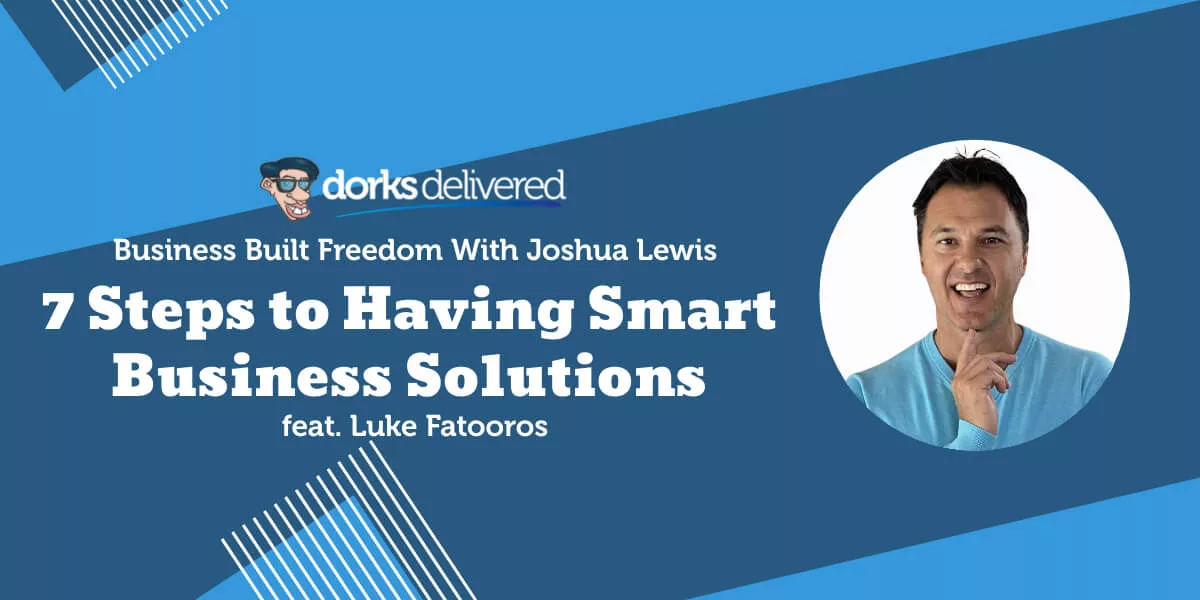We’ve all been in a spot in our business where we’re trying to work out how to get from A to B. Luke Fatooros from Ideas Into Business shares with us the seven steps to building a smart business engine to give you time, money, and freedom.
Build a Solid Foundation
1. Understand Cash Flow
I had to learn how money works and how money flows. The first lesson was to stop trading time for money—I didn’t know what that meant. When I lost my first business, I learned the difference between being self-employed and being a business owner, and I realised that my business was worth nothing because it was strapped to me.
2. Work on Your Internal Structure
I built a second business. It’s a distribution business, and I had a factory in China, the Philippines, and Korea. I’m supplying five countries from a desk. If someone saw me with my notebook at my home office, they would think it’s a joke, a hobby. But it’s not how fancy a business looks on the outside. It’s how structured internally.
3. Own Your Role
Luke: You cannot step out of the engine. You cannot hand down management or the responsibilities with regard to the foundation of your business to anyone else.
If you have a vehicle that’s got a broken engine, you cannot paint it green hoping that the engine would work. In business, don’t change the website or invest in social media marketing and think this is going to grow the business if you haven’t built a strong foundation.
Turn IT into a utility that will help grow your business. Talk to a dork about your business needs.
Seven Solutions to Build a Smart Business
1. Optimise Your Mindset
People have a business idea, but people focus on marketing strategies, negotiation, sales, systems, processes, etc. But there’s a thing called you.
We all have our own personal brands. People don’t buy your products and services. They buy you. They buy the image that you are projecting. Every one of us projects a particular image that we think we need the world to see.
Every one of us has self-sabotaging patterns and limiting beliefs. It doesn’t matter how fancy you get into your marketing sales strategy. If you have this self-sabotaging pattern, your business is just never going to make it. We might think we’re marvellous, but the truth is we’re not. You want to be the best version you can be of yourself and your business. You must pay attention to how your customers perceive you.
The people who resist openness, self-development, and willingness to learn are the ones who desperately need this help the most. That’s the self-sabotaging trait. That is a disaster in business. Optimise your mindset.
2. Optimise Your Niche
There are many lucrative niches, and the money is naturally flowing into those lucrative niches. The common mistake is when we have meat, we try to sell it to vegetarians. It doesn’t matter how fancy your meat is; a vegetarian is just not going to buy your meat.
A lot of marketing companies say identify your ideal customer, but that doesn’t mean those people are going to buy from you. Out of 100 people, there will be some of them who buy from you instantly—they love you and your brand. These are your real customers.
When you’ve been in a business or you’ve been trading and you look back at your history, you see that there’s a group that just hands you cash. Shift your focus toward your real customers, not your ideal customers.
If you are struggling in business, find where the money is flowing. Listen to your customers, what they are looking to buy, instead of ramming your product down their throat. Shift and sift to what the market really wants.
My first business really took off because we’ve shifted and sifted out of selling computer software, which was a dead niche. You can’t keep flogging a dead horse, right? You have to be smart enough to move across. The people who ultimately fail are those who will not let go of their idea.
If you’ve got a bit of history in your business, you can take the time to analyse your database and then categorise them into A, B, and C clients.
A – Who are the people who are just paying you and not giving you problems?
B – Who are the people who buy from you after some hard work?
C – Who are the people who won’t just buy from you?
It’s not about percentages, time, staff, or size. It’s the process. Analyse, and then you’ll be fine.
Revolutionise your business technology. Turn your IT into a utility.
3. Optimise Your Sales
Luke: I’ve been in business since I was 23. I’ve done probably every sales course under the sun, and I’ve never seen anything that’s told me: don’t sell.
When people walk in, there’s one thing they are subconsciously looking for: trust.
If I don’t trust you, I don’t care how fancy your product is, I’m not going to buy from you. I’m going to try and find someone else who I feel comfortable with to give my money to.
I’ve never heard a sales course ever tell me that. They all try to show how to influence, trick, close, overcome objections, etc. to get the money in the bank.
4. Optimise Your Marketing
Luke: Many businesses fail in marketing because they try to talk to everyone. When you try and talk to everyone, no one hears you.
Look at your niche and determine the difference between your ideal customers and your real customers. Look at what products and services these people buy from you the quickest and the easiest. Now that you understand who you are selling to and what you are selling to them, that’s the time to work on your marketing.
As a smart business owner, you should gear your energy, effort, marketing, sales pitches, and presentations towards that. But a lot of businesses keep doing the same old thing every day, and that’s hard work. That’s not what you call a smart business.
Most people want to start by building a website and doing digital marketing, getting their Facebook page up, etc. They pay companies $2,000-$3,000 a month to do this stuff and they wonder why nothing happens. It’s because your first few steps have not been cemented.
In my first business, we were selling computers, but who buys a computer? You can have an IT manager for corporate, a small business owner, gamers, bargain hunters, and families. Those are five very different niches.
You have to create a resonating message, the X factor. You can’t have a resonating message talking to all those people in five different niches.
My advice is to go into lucrative niches. I often get resistance when I talk about this. They say, “No one’s thought of this idea so there’s no competition. We should go there.” No, you shouldn’t.
Smart businesses go where the money flows. If no one’s doing it, that means it’s a dead niche.
However, when you go to where the money is flowing, there’s competition and that’s okay. You can establish your X factor by doing the following:
- Know the deepest pains and problems of your real customers.
- Find out their most powerful desires, which I call your anchor points.
- Analyse your competition. What is the competition doing wrong? Do not do it.
One of the other businesses that I created from scratch was a cartridge distribution business. Many people find it hard to remember their printed model number. People walk into a shop, buy a cartridge, and come back because the ink wouldn’t fit in the printer.
So to create our X factor, we put pictures on the cartridges. Granny could go and then just buy the “parrot” or you could tell your husband to just pick up the “strawberry.” There’s no confusion. My X factor is simply no more complicated numbers.
Create a system to build a business that will give you freedom. Let’s talk!
5. Optimise Your Efficiency (and Your Quality of Life)
The real money is not in your products and services. It’s in your ability to leverage your energy to sell them. This is how you start to release yourself from the daily grind.
All the stuff has to be in place and then you’re ready to start to optimise efficiency. You want to build a smart business engine that does the work for you.
There are four ways to become efficient.
- Stop trading time for money.
- Have an unlimited earning structure.
- Systemise your business.
- Join ventures.
Help your team to boost productivity by turning IT into a utility. Contact us for more details!
6. Optimise Your Team
Managing and motivating staff is the biggest challenge in business. Here are ways to optimise your team.
- Show them how they contribute to the bigger picture. Where is this company going? How can they see themselves grow in this company? How can they fuel their potential (although not every staff member is interested in this, but some people want to grow).
- Structure first, staff second. What is the optimised structure to make this business work? You then put staff in that structure.
- Don’t be held to ransom by one staff member threatening to leave or whom you think this entire business holds onto. You, as the leader, are the central cog. Your staff is important, but your structure is more important.
- Adhere to a chain of command. No bypassing, no grey areas. If you’re going to pass the buck, play below the line, and hold no accountability, your team is going to copy that. Your culture is going to be a disaster.
- Have the right incentives. Not every staff member is incentivised by money. It can be education, family, or other values.
- Attitude beats skills and trophies. You can teach them skills, but you can’t teach attitude.
Grow your business! Learn how you can turn IT into a utility.
7. Optimise Your Business Value
My partner, Gary, and I would go to work, work our butts off, and kill ourselves to make profit. I learned that’s the wrong way to do it. You don’t get rich by trying to make profits.

What you have to do is learn to create wealth in your business. There’s a difference between working for profits today versus creating wealth for your future.
If you take into consideration the first six steps and implement it in your business, you will be moving from being self-employed to being a business owner.
When you’re working on building your business, think of it as an asset you’re creating for life. You’re not doing it just to make profits, pay the bills and get through the day. You don’t want to come off to three, four or five years and have nothing of value because you have built your business the wrong way.
If you are struggling in your business for growth or you’re killing yourself for time, cash flow, or profit, that’s a structural problem and we have to start at the beginning.
Everything has to line up before your life changes—your smart business solutions start to work for you. Most people go to business to have a lifestyle of their choice, but how many business owners can say that? Some are working until midnight, weekends, holidays, while missing their kid’s birthdays for trying desperately to make the business work.
See the blueprint of the seven steps to building a smart business engine and get access to more examples, case studies, and testimonials.
Join Luke’s master class for free!
Turn your IT into a utility! Book a free discovery session to find out how much time and money you can save with the help of technology.
[module-379]
































